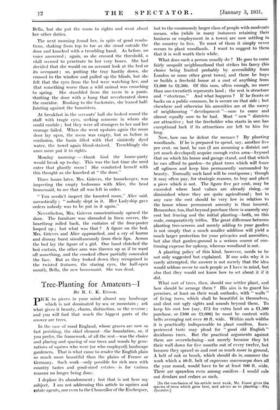Tree-Planting for. Amateurs—I
BY R. C. K. Exson.
DICK to pieces in your mind almost any landscape which is not dominated by sea or mountain ; ask what gives it beauty, charm, distinction, or the reverse ; and you will find that much the biggest parts of the answer arc trees.
In the case of rural England, whose graces arc now so fast perishing, the chief element—the foundation, or, if you prefer, the framework, of all the rest—was the choice and placing and spacing of our trees and woods by gene- rations of squires who were (or who employed) landscape gardeners. That is what came to render the English plain so much more beautiful than the plains of France or Germany. Such work—only possible for rich men with country tastes and good-sized estates---is for various reasons no longer being done..
I deplore its abandonment ; but that is not here my subject. I am not addressing this article to squires and . estate agents, nor even to. the Chancellor of the Exchequer, but to the enormously larger class of people with moderate means, who (while in many instances retaining their business or employment in a town) are now settling in the country to live.. To most of them it simply never occurs to plant woodlands. I want to suggest to them that it is well worth their while.
What does such a person usually do ? He goes to some fairly unspoilt neighbourhood that strikes his fancy. (his choice being limited probably by accessibility from London or some other great town), -and there he buys or builds a freehold house at a cost of anything from £1,000 to £2,500. Of this sum, often enough, no more than one-twentieth represents land ; the rest is structure and " etceteras." And what happens ? If he fronts or backs on a public common, he is secure on that side ; - but elsewhere and otherwise his amenities are at the mercy of neighbouring " development "—sure to come and almost equally sure to be bad. Most " new " districts are attractive ; but the freeholder who starts in one has exceptional luck if its attractions are left to him for long.
Now, how can he defeat the menace ? By planting woodlands. If he is prepared to spend, say, another five per cent. on land, he can (I am assuming a district .not- yet much developed) acquire enough extra area—beyond that on which his house and garage stand, and that which he can afford to garden—to plant trees which will fence off ugliness and keep him permanently surrounded by beauty. Normally such land will be 'contiguous ; though it may often pay, for strategic reasons, to buy and plant a piece which is not. The figure five per cent. may be exceeded where land values are already rising, or diminished 'where they are quite agricultural ; but in any case the cost should be very low in relation to the house whose permanent amenity is thus insured.• Remember, too, that beyond purchase there is scarcely- any cost but fencing and the initial planting—both, on this scale, comparatively trifles. The great difference between planting tree-screens and merely adding to your garden is not simply that a much smaller addition will yield a much larger protection for your privacies and amenities, but also that garden-ground is a serious source of con- tinuing expense for upkeep, whereas woodland is not.
A planting policy of this kind, however, needs to be not only suggested but explained. If one asks. why it is rarely attempted, the answer is not merely that the idea would seldom occur to such people as I have in mind, but also that they would not knoW how to set about it if it did..
What sort of trees, then, should our Settler Plant, and. how should he arrange them ? HiS aim is to ill- ard his premises, at least on their weak outlooks, with " walls of living trees, which shall be beautiful in themelves, and shut out ugly sights and sounds beyond them. To keep his cost low (say, £75 for extra land on a £1,500 purchase, or £100 on £2,000) he must be content with belts averaging not over 40 ft. wide. Within such widths it is practically indispensable to plant conifers. Inex- perienced taste may plead for " good old English " deciduous trees. But the practical arguments against them are overwhelming-7-not merely beCanse they let their wall down for five months out of every tWelVe, but because they sprawleso and cost. so much more in ground. A. belt of oak orbeech, which should do in, sumnier the work which a 40-ft. belt of cupressus macrocarpa does all the year round, would have to be at least 100 ft. wide. There are sprawlers even among conifers—I would rule out deodars and cedars as such.
[In the conclusion of his article next week, Mr. Epsor gives the species of trees which grow best, and advice as to pliutting.—Eni Spectator.]






































 Previous page
Previous page